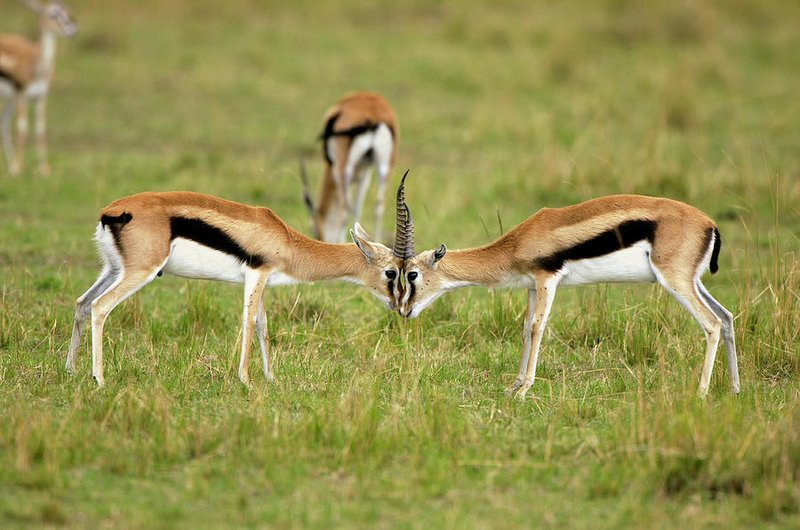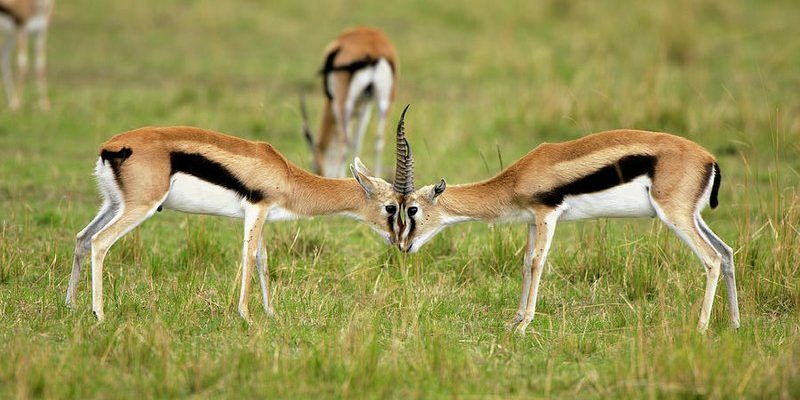
The Thomson’s gazelle, often affectionately called the “Tommie,” is one of the most iconic symbols of African wildlife. Picture a creature that embodies grace and speed, darting through the plains of East Africa with an elegance that seems almost effortless. Recognized for their slender bodies and swift movements, these gazelles have captured the hearts of wildlife enthusiasts and casual observers alike. Watching a Thomson’s gazelle leap gracefully across the savannah is like witnessing a ballet performance in the wild, full of energy and beauty.
But there’s more to these fascinating animals than their physical charm. They play a vital role in their ecosystem, serving as prey for various predators while also influencing the vegetation growth through their grazing habits. Their unique adaptations enable them to thrive in the arid landscapes they call home, making them truly remarkable creatures. So, let’s dive deeper into the world of Thomson’s gazelles and uncover the aspects that make them so special.
Physical Characteristics
Thomson’s gazelles are compact and agile, measuring about 26 to 34 inches tall at the shoulder. They typically weigh between 40 to 65 pounds. Their coats are a beautiful tawny color, perfectly suited to blend in with the dry grasses of their habitat, while the striking black stripe along their sides adds a dash of flair to their appearance. The males are often slightly larger than the females and are easily identified by their long, slender horns that can reach up to 18 inches in length.
One of the most astonishing features of these gazelles is their incredible speed. They can reach speeds of up to 50 miles per hour, making them one of the swiftest land mammals. This extraordinary speed is complemented by their agility, allowing them to make sharp turns and sudden jumps to evade predators. Think of them as the Olympic athletes of the animal kingdom, perfectly designed for a life of sprinting through the savannah.
Habitat and Range
Thomson’s gazelles inhabit the open grasslands and savannas of East Africa, primarily found in countries such as Kenya and Tanzania. These areas offer a vast expanse of land for grazing, as well as safety from dense forested regions where larger predators might lurk. You might imagine these gazelles as the original nomads, constantly on the move in search of fresh pastures and water sources. Their migration patterns are often influenced by the availability of food and seasonal rains.
While they thrive in these open habitats, Thomson’s gazelles are also quite adaptable. They can often be spotted in various terrains, including shrublands and even the edges of woodlands. However, their presence in more wooded areas is less common due to the cover that can hinder their speedy escape from predators. Thus, they prefer the wide-open spaces where they can easily spot dangers and flee at a moment’s notice.
Diet and Feeding Habits
As herbivores, Thomson’s gazelles primarily feast on grasses, making them grazers of the savannah. They have a particular fondness for short grasses, which are abundant in their native habitats. Their specialized digestive system is well-suited for processing fibrous plant material, enabling them to extract the necessary nutrients to thrive. You could say that they are nature’s lawnmowers, playing an essential role in maintaining the health of the grasslands they inhabit.
Interestingly, these gazelles have adapted to cope with the dry seasons when food is scarce. During these times, they may move to different grazing grounds or even switch to browsing on shrubs and leaves when grass is hard to come by. This flexibility allows them to survive in harsh conditions, proving that these nimble creatures can thrive even when the going gets tough.
Social Structure and Behavior
Thomson’s gazelles are social animals and often form small herds, typically consisting of females and their young. Males are usually solitary or form loose bachelor groups, especially during the mating season. These herds provide safety in numbers, allowing individuals to alert one another to potential threats. Just think about it: it’s a herd mentality that helps them survive in a world where predators lurk around every corner.
During the breeding season, the males become more competitive, establishing territories that they defend against rivals. They will engage in displays of strength, such as posturing and sparring with their horns, to attract females. Interestingly, female Thomsons may choose mates based on their strength and territorial displays, leading to a fascinating dance of courtship that’s all part of their natural cycle.
Predators and Threats
Thomson’s gazelles are part of a larger web of life, and as such, they have their share of predators. Lions, cheetahs, and hyenas are among the most common threats. Their swift speed and agility are their primary defenses against these formidable hunters. During a chase, the gazelles can make sharp turns and leaps that help them escape the jaws of danger. It’s a high-stakes game of survival that plays out daily in the vast African savannah.
However, Thomson’s gazelles also face threats from habitat loss due to agricultural expansion and human encroachment. As humans continue to develop land for farming and settlements, these gazelles may find their living spaces shrinking. Conservation efforts are crucial to ensure these iconic animals continue to roam the plains they call home, and protecting their habitats is a significant step towards that goal.
Reproduction and Lifespan
The mating season for Thomson’s gazelles typically peaks during the rainy season when food is plentiful. After a gestation period of about six to seven months, a female will give birth to a single calf, although twins can occasionally occur. The calves are remarkably precocious and can stand and run shortly after birth. This ability is vital in the wild, where every second counts when avoiding predators.
Once born, the young gazelles are often hidden in tall grasses to protect them from predators. The mother will return periodically to nurse her calf and offer protection. As they grow, these young gazelles begin to join the herd and learn essential survival skills by watching and mimicking adult behaviors. In the wild, Thomson’s gazelles typically live for about 10 to 12 years, but they can live longer in protected environments such as wildlife reserves.
Conservation Status
Currently, Thomson’s gazelles are classified as Least Concern by the International Union for Conservation of Nature (IUCN), meaning they are not immediately threatened. However, their populations are impacted by habitat loss and hunting. Protection of their natural habitats, alongside the establishment of wildlife reserves, is vital for ensuring their continued existence. Organizations and local governments are working together to create sustainable practices that help balance human needs with wildlife conservation.
Conservation efforts also focus on awareness and education, encouraging local communities to participate in protecting their native wildlife. By highlighting the importance of Thomson’s gazelles in the ecosystem and promoting eco-tourism, these initiatives aim to foster a sense of pride and responsibility toward nature.
Interesting Facts about Thomson’S Gazelle
| Scientific Name: | Eudorcas thomsonii |
| Size: | 26 to 34 inches tall |
| Weight: | 40 to 65 pounds |
| Speed: | Up to 50 miles per hour |
| Diet: | Grasses and leaves |
| Habitat: | Open grasslands and savannas |
| Lifespan: | 10 to 12 years in the wild |
FAQ
What is the habitat of Thomson’S Gazelle?
Thomson’s gazelles primarily live in the open grasslands and savannas of East Africa. They thrive in regions where there’s plenty of grass and space to run, as these features help them evade predators. Their habitat can range from short grass plains to slightly shrubby areas, but they usually steer clear of dense forests where escape routes are limited.
How fast can Thomson’S Gazelle run?
These remarkable creatures can reach speeds of up to 50 miles per hour, making them exceptionally swift runners. This speed, combined with their agility, allows them to navigate quickly through their environment and evade predators like lions and cheetahs. Think of them as nature’s sprinters, always ready to sprint at a moment’s notice.
What do Thomson’S Gazelles eat?
As herbivores, Thomson’s gazelles mainly graze on grasses, particularly short grass species that thrive in their natural habitats. During dry seasons, when grass is scarce, they may adapt their diet to include shrubs and tender leaves. Their ability to switch from grazing to browsing is an excellent survival tactic in their sometimes harsh environment.
How do Thomson’S Gazelles defend themselves from predators?
Thomson’s gazelles rely on their speed and agility to escape from predators. When threatened, they can perform swift sprints and sharp turns, making it challenging for predators to catch them. Additionally, their keen eyesight allows them to spot danger from a distance, giving them a head start when fleeing. It’s a combination of vigilance and physical prowess that keeps them alive.
Are Thomson’S Gazelles social animals?
Yes, Thomson’s gazelles are quite social and often form herds. These herds typically consist of females and their young, while males may be solitary or form loose bachelor groups. Their social structure helps with food foraging and provides safety in numbers, allowing them to alert each other to potential threats in their surroundings.
What threats do Thomson’S Gazelles face?
Thomson’s gazelles face several threats, including predation from big cats such as lions, cheetahs, and leopards. Additionally, habitat loss due to agricultural expansion and human encroachment poses a significant risk. Conservation efforts are essential to protect their habitats and ensure these gazelles continue to thrive in the wild.
How long does a Thomson’S Gazelle live?
In the wild, Thomson’s gazelles typically live for about 10 to 12 years. However, those in protected environments, like national parks and wildlife reserves, can potentially live longer, thanks to reduced predation and better access to food and water. Their lifespan can vary based on several factors, including available resources and the presence of predators.
What is the breeding behavior of Thomson’S Gazelles?
Thomson’s gazelles breed during the rainy season when conditions are favorable. After a gestation period of six to seven months, females usually give birth to a single calf. The young are capable of standing and running shortly after birth, which is crucial for their survival in the wild. Breeding behavior includes males establishing territories and displaying strength to attract females.
How are conservation efforts helping Thomson’S Gazelles?
Conservation efforts focus on protecting the natural habitats of Thomson’s gazelles, as well as raising awareness about their ecological importance. Programs that promote sustainable land management and eco-tourism help foster a sense of responsibility among local communities toward wildlife conservation. By ensuring their habitats remain intact, these efforts play a critical role in preserving the species.

